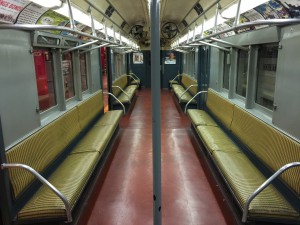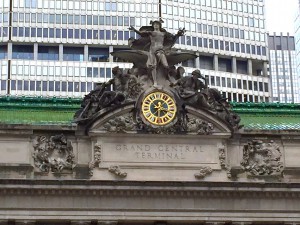Author Archives: Byron Ullauri
NYC Transit Museum & Archives
Visiting the NYC Transit Museum and the Archives was a great experience and definitely one I found Interesting. Firstly, it was amazing looking through old photographs of the city back in the early 1900’s, particularly Bryant Park and Times Square. In the Bryant Park photos, it was interesting to see the place wide and open as oppose to it being surrounded by buildings today. On the top right corner of one photo, you could see advertisements for the Barnum and Bailey circus and even more incredible what looked like a Wrigley’s spearmint gum ad, both of which are still around to this day. With Times Square, you could still see how it was a place that got crowded even back then. Also, The bottom of that one building where the New Years ball drops could still be seen. Lastly, out of the many more things we saw in those photos, the one thing that stood out in all of them was the clothing people wore.
Inside the Transit Museum, I enjoyed seeing how the subways and tunnels were made. The various photos and displays of the tools used painted a good picture of what it must have been like back then. Specifically, they had this one mock up of a wheelbarrow with actual rocks in it that weighed about half of what workers back then typically moved; The purpose of it was to try to lift it so you could see how much hard work was put in back then. Looking at the different variations of turnstiles over the years was cool too. Something new I learned was that back when they used tokens to pay for the subway, they had something called ‘slugs’ which was a term used to describe counterfeit tokens. By far, the thing that caught my attention the most was looking at and actually stepping into the old trains found on the lower level of the museum. From the outside, not much but the paint job and style of display changed over the years. The more interesting stuff was found inside. Things like old advertisements, signs, and fans were interesting to look at; the seats were what made the display amazing. What was funny about them was how they were more comfortable back then, with the cushioned seats and all, and how they slowly came to be the uncomfortable ones we have now.
New York Central System. (1970). Grand Central Terminal [Brochure]. New York, NY: Author. This pamphlet/brochure contains information about Grand Central Terminal such as a brief overview of its history, current events located there, and more. Meant for those visiting New York, specifically the Terminal, it shows old photographs of Grand Central dating back to circa 1970 along with short captions detailing the place’s significance.
The Gateway to a Continent. (1940). New York, NY: New York City Architects. A book containing information about various hotels in NYC during the 1940’s. Composed of brief description of each hotel including details such as, the location, nearby structures along with photographs and draws of them.
The Bowery Boys Podcast
The 45th episode of The Bowery Boys podcast was a general overview of Grand Central from its start as a Depot to the Current Terminal we see today. Having done three tours of the place, The Bowery Boys didn’t really mention much I hadn’t heard before. For Example, they talk about it being a Depot that had train tracks cutting through bare land with horses and houses in what is now midtown Manhattan. Following that, the first few years in the 1900’s saw the creation and use of Grand Central Station. What was interesting about the Station was its short lifetime. Due to all the smoke blocking the site, there was an eventual train crash that lead to the need of addressing the proximity of the smoke and trains to the city; which lead to the creation of tracks underground. Following that they touched on Grand Central Terminal and its history mentioning things such as it being responsible for introducing electricity to the city and the creation of park avenue after the real estate there was sold. One thing I was unaware of was that the windows inside the Terminal were blacked out during WWII. There were also some things on Vanderbilt’s life that were unknown to me. For instance, The Bowery Boys mentioned that he was in the peak of his success in ferries when he decided to venture off into railroads. In addition to this, I did not know he was 75 years old when he started buying out railroad companies and land to build Grand Central.
GCT Tour 6/16/2016
Today’s tour was interesting in that we got to learn more about the design and in-depth history of Grand Central in its early days. The fact that Grand Central was purposely place in mid-town because it was once unused land away from the city, and, likewise, the way Grand Central used that land later on to gain funds were both interesting facts. Another thing that I learned was that the Tiffany clock on the front of GCT, at 14ft in diameter, is the largest Tiffany clock in the world. Lastly, I found it surprising to see those long plates on the ground when we walked on the bridge streets over the trains.
The William Wilgus Papers
William John Wilgus was a civil engineer involved in numerous railroad constructions during the turn of the century; his most notable project being his involvement in Grand Central Station. During his career, William Wilgus created records of his work throughout various projects where he held roles such as: supervisor, advisor, chief engineer, director, researcher, general, and chairmen. Together, along with other documents of his merits, these records form a collection that is now known as The William Wilgus Papers. A total of eight, The William Wilgus Papers are arranged as groupings (series) of records based on the specific project/period-of-work they are related to; making the content within each series self-explanatory. To clarify this, the series, starting from I to VII, consists of I. New York Central & Hudson River Railroad, II. American Expeditionary Forces – Transportation Corps, III. Private Consulting Practice, IV. Public Service Activities, V. American Society of Civil Engineers, VI. Writings, Research Notes, and Related Correspondence, VII. Artifacts and Oversize Material, and an eighth grouping called General Client Files. Furthermore, The NYPL (New York Public Library) Archives website also lists important names, subjects, occupations, and material types mentioned. You can find The William Wilgus Papers at the Stephen A. Schwarzian Building inside the Manuscripts and Archives Division.
Site Report #1 GCT
Grand Central…The Worlds Greatest Railway Terminal
Title: Grand Central…The World’s Greatest Railway Terminal
Author: William D. Middleton
Date: 1977
Table of Contents: (8 Chapters)
1. The Railroad Comes to Manhattan
- Talks about the establishment of railroads in the city along with the companies and people who ran them leading up to GCT.
2. The Commodores Palace on 42nd Street
- Gives a brief overview of Cornelius Vanderbilt’s early life up until his involvement in the development of GCT.
3. An Engineer and His Grand Design
4. The Architects and Their Magnificent Structure
5. A Prodigious Task Wonderfully Accomplished
6. A City Within a City
7. Gateway to a Continent
8. What Future for Grand Central
Grand Central Wiki (Ullauri)
One of the perks of living in such an amazing city as New York is the ease with which you can find significant buildings all around you. Regardless of what borough your in, New York City has years of history that can be unveiled by simply choosing the right structure to look at. An example of this can be found by studying Manhattan’s iconic railroad, Grand Central Terminal. After reading the Grand Central Terminal Wikipedia page, I found various facts about the rail road that I had no idea of. For starters, it is claimed as being one of the world’s most visited tourist attractions. It’s 44 platforms make it the rail road with the most platforms in the world. In addition to this, a random fact I found is that it’s more commonly known and referred to as Grand Central Station, which is the name of a nearby post office and not the actual rail road. On the more unusual side, the Terminal has a secret basement beneath the last floor that houses AC-DC converters. Apparently, this sub floor, known as M42, does not show up in any maps and has been a well kept secret that played a key role in World War 2. Finally, another fact that was surprising to me is that prior to it’s construction/layout, the final design for the Terminal was chosen through a competition that required participating firms to depict their version of what Grand Central should look like. Overall, the wiki page gave me enough facts to get me interested in the subject, but did so in a way that made me want to know more about it.














